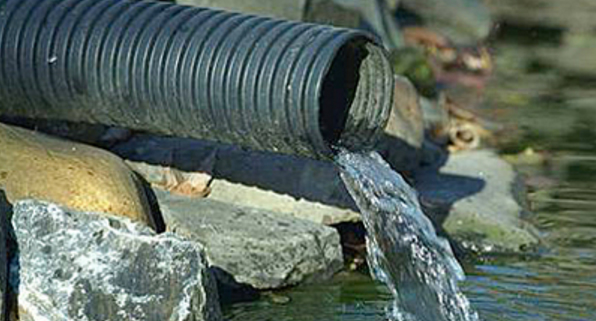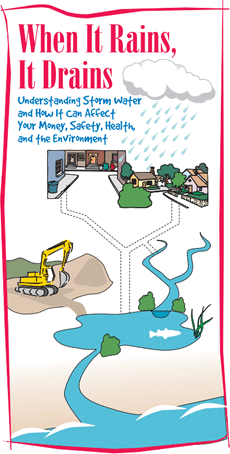MS4 – Stormwater Education Program
Overview and Definition of an MS4
Clean water is important to us because it provides us with drinking water, a place for recreation, and supports habitat for wildlife. Girard Borough has initiated a public education program on storm water management because of its effect on water quality. According to the United States Environmental Protection Agency, polluted storm water runoff is a leading cause of impairment to the nearly 40 percent of U.S. water bodies which do not meet water quality standards.
Storm water is water from precipitation that flows across the ground and pavement when it rains or when snow and ice melt. Storm water travels over land. Sometimes the ground absorbs storm water, and it never reaches streams, rivers, and lakes. Other times storm water traveling over land eventually drains into a system of conveyances. This system is referred to as a municipal separate storm sewer system (MS4). By definition an MS4 is a system of conveyances that include catch basins, curbs, gutters, ditches, man-made channels, pipes, tunnels, or storm drains that discharges into waters of the United States. An MS4 moves water away from an area to a local water body. The EPA is now requiring certain urbanized municipalities to address storm water quality. The Pennsylvania Department of Environmental Protection has outlined a program for Municipal Separate Storm Sewer Systems (MS4’s). In Pennsylvania Phase I of the program focused on large and medium sized cities above 100,000 population (Philadelphia, Pittsburgh, & Allentown). Girard Borough is one of about 900 municipalities in Phase II of the program. We are required to educate the public as part of a 5 year permit program.
Storm Water Runoff
When it rains, the draining water is called storm water runoff. Storm water can be a problem when there is a decrease in quality and an increase in quantity. Development can alter the natural pathway that storm water takes to travel over land, and increases the rate at which it travels over the land by changing porous surfaces (soil) to non-porous, or impervious surfaces (pavement). Natural surfaces, such as soil, act as a filter for storm water and clean it as it infiltrates into the ground.
 When a pervious surface is converted into an impervious surface, pollutants on the surface are collected by the storm water as it travels over the land, and deposits them into water when it discharges from the MS4. As a result of developed and disturbed land, storm water becomes a problem because the quality of the storm water runoff decreases as it accumulates pollutants that collect on the ground. Pollutants concentrated in storm water runoff eventually decrease the overall water quality of lakes, rivers, and streams that receive storm water discharges. The quantity and speed of storm water runoff moving over the land increases. This means that a greater volume of polluted runoff is reaching our lakes, rivers, and streams at a faster pace. This can result in flooding, as well as more polluted waters. As the amount of impervious surfaces in our community increases by creating more roads, rooftops, and parking lots, the quantity of storm water increases. If the storm water system cannot drain the runoff from impervious surfaces quickly enough, flooding can result. Storm water runoff picks up litter from streets and carries it to storm drains. Sometimes litter will clog an inlet and make it difficult for storm water to drain properly. This could lead to flooding if the drain is clogged enough. Storm water runoff can also contribute to erosion from areas that do not have vegetative cover, such as construction sites. We can see pollutants such as sediment. Pollutants that we can’t see, such as bacteria and toxic chemicals, could result in illness.Thermal impacts from storm water runoff heating up as it travels over hot pavement can harm aquatic life that need cool water to survive. Illicit discharges, such as dumping antifreeze down a storm drain, are an example of how a contaminant can enter the storm sewer system and contribute to storm water contamination. It is important to understand that wastewater from the sanitary sewer system gets treated. Storm water traveling trough a separated storm sewer system never gets to a treatment plant. It discharges directly to our water, along with everything it picks up on its journey over the land. Storm water, which does not get treated, becomes a problem when it picks up debris, chemicals, dirt, and other pollutants as it flows eventually reaching a lake, river, stream, wetland, or coastal water.
When a pervious surface is converted into an impervious surface, pollutants on the surface are collected by the storm water as it travels over the land, and deposits them into water when it discharges from the MS4. As a result of developed and disturbed land, storm water becomes a problem because the quality of the storm water runoff decreases as it accumulates pollutants that collect on the ground. Pollutants concentrated in storm water runoff eventually decrease the overall water quality of lakes, rivers, and streams that receive storm water discharges. The quantity and speed of storm water runoff moving over the land increases. This means that a greater volume of polluted runoff is reaching our lakes, rivers, and streams at a faster pace. This can result in flooding, as well as more polluted waters. As the amount of impervious surfaces in our community increases by creating more roads, rooftops, and parking lots, the quantity of storm water increases. If the storm water system cannot drain the runoff from impervious surfaces quickly enough, flooding can result. Storm water runoff picks up litter from streets and carries it to storm drains. Sometimes litter will clog an inlet and make it difficult for storm water to drain properly. This could lead to flooding if the drain is clogged enough. Storm water runoff can also contribute to erosion from areas that do not have vegetative cover, such as construction sites. We can see pollutants such as sediment. Pollutants that we can’t see, such as bacteria and toxic chemicals, could result in illness.Thermal impacts from storm water runoff heating up as it travels over hot pavement can harm aquatic life that need cool water to survive. Illicit discharges, such as dumping antifreeze down a storm drain, are an example of how a contaminant can enter the storm sewer system and contribute to storm water contamination. It is important to understand that wastewater from the sanitary sewer system gets treated. Storm water traveling trough a separated storm sewer system never gets to a treatment plant. It discharges directly to our water, along with everything it picks up on its journey over the land. Storm water, which does not get treated, becomes a problem when it picks up debris, chemicals, dirt, and other pollutants as it flows eventually reaching a lake, river, stream, wetland, or coastal water.
Polluted storm water runoff can have these adverse effects:
- Sediment can cloud the water and make it difficult or impossible for aquatic plants to grow.
- Bacteria can wash into swimming areas and create health hazards.
- Plastic bags, six pack rings, bottles, and other debris washed into water bodies can disable aquatic life such as ducks, fish, turtle, and birds.
- Household hazardous wastes such as insecticides, pesticides, paint solvents, used motor oil, and other auto fluids can poison aquatic life. Land animals and people
- can become sick or die from eating diseased fish or ingesting polluted water.
- Polluted storm water can affect drinking water, which can affect human health and increase drinking water treatment costs.
- Waste from chemicals and materials used in construction can wash into the storm sewer when it rains.When left uncontrolled, this can result in the destruction of fish, wildlife, and aquatic life habitats; a loss in aesthetic value; and threats to public health due to contaminated food, drinking water supplies, and recreational waterways.
Ways to prevent storm water pollution are as follows:
- Never pour any hazardous substance such as used oil, cleaning supplies and paint down any part of the storm sewer system.
- Use pesticides and fertilizers sparingly to prevent excess runoff.
- Never dump automotive fluids into storm drains.
- Correct motor vehicle leaks (vehicles drip fluids such as oil, grease, gasoline, antifreeze, and brake fluid).
- When walking your pet, pick up the waste and dispose of it properly. Leaving pet waste on the ground increases public health risks by allowing harmful bacteria to wash into the storm drain and eventually into local water bodies.
- Sweep up litter and debris from sidewalks, driveways, and parking lots especially around storm drains to avoid having it wash into the storm sewer system.

